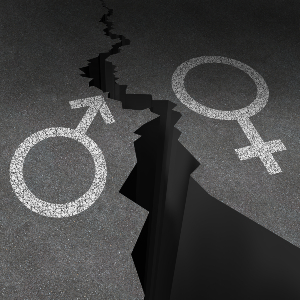
Previous iterations of this column have looked at the gendered gaps that exist within the data world and how said gaps can begin to be closed, but all of this begs the question: Why is there so much research and information about how gender equity would help the general population, and little to none on how to actively make that future a reality?
One case study where this issue is currently prominent is domestic labor. There is an increasing amount of literature about how the division of household work among heterosexual couples is generally toxic and making it more equitable would lead to a healthier population overall. This topic gained a great deal of limelight at the onset of the COVID-19 pandemic, when an unprecedented amount of the workforce began working from home at the same time their children began learning remotely.
A variety of articles about the effects of this gained traction, including the Center for American Progress’ report titled, How COVID-19 Sent Women’s Workforce Progress Backward. The report estimated that “if conditions for families do not improve—and if the levels of maternal labor force participation and work hours experienced during the April 2020 first-wave peak of infections and COVID-19 lockdowns persist long term—lost wages would amount to $64.5 billion per year […] without a significant public response, these consequences will have additional ripple effects that will continue to hurt communities and stifle the economic recovery.” However, although this issue became clear very quickly, there has been little written about what we can do to stop it.
This realization is not limited to the most recent pandemic. Women are increasingly entering post-secondary education and the workforce, even surpassing the percentage of men present in both areas, but a 2019 Gallup poll shows that they are still completing the majority of domestic work at home. While this gap in labor has been studied relatively extensively, there is a chasm in the literature when it comes to how to address and close the labor gap.
It has been found that egalitarian approaches to housework have positive effects on women’s emotional health and marital satisfaction and on men’s emotional development (Coltrane 2000; Milkie et al. 2002; Mintz and Mahalik 1996). This has also led to an increased chance of producing children, and improved the economy (Dommermuth et al, 2017; Maceira 2017). If we have so much data on how domestic equity improves the well-being of people of all genders, where is the data about how we can achieve this?
A study, titled Gender Equality in the Family and Childbearing by Dommermuth et. al., seeks to examine the relationship between division of housework and childcare and the actualization of building a larger family in couples that seek to do so. The authors’ initial examination of the topic shows that in progressive Norway, households are more likely to have equitable division of childcare than of housework such as cooking and cleaning. Additionally, it was found that couples with an unequal division of housework have lower childbearing rate than couples with equitable division of labor. It follows that the “incomplete gender revolution” will be focused largely on tasks such as cooking, cleaning, and homemaking. All this implies that domestic equality is correlated with reaching one’s familial goals.
In servitude of the aforementioned data gap, this shows that household labor is in higher need from male partners than childcare, and the former is very commonly provided in home economics classes, while the latter is generally not. The authors found that when housework is equally divided, couples are more likely to have an initial or additional child and to have children sooner (Buber, 2002; Mencarini & Tanturri, 2005; Mills, Mencarini, Tanturri, & Begall, 2008; Oláh, 2003; Tazi-Preve, Bichlbauer, & Goujon, 2004; Torr & Short, 2004).
With all of this research in mind, it seems irrational that we have continued to collect data that proves a certain phenomenon exists, long past the burden of proof has been overtaken, rather than seeking out data that shows us how to address it. To what end are we gathering information, if not to use it for the betterment of our systems and societies? What does it say about us if we live in a world where thousands of people jump to use hydroxychloroquine to prevent COVID-19 without any proof that it works, but we are endlessly burdened to provide evidence of gender inequity before we may begin researching how to address it?
Tune in next quarter to read about ideas of new ways to gather and utilize data in order to make it as helpful as possible.
